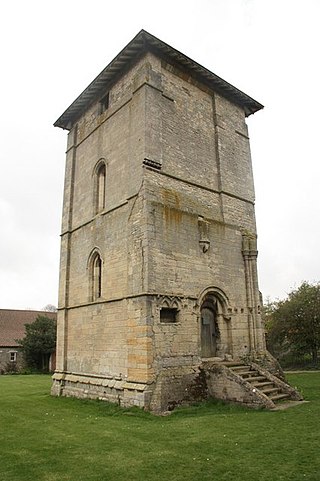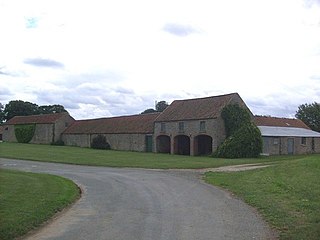Related Research Articles

Temple Bruer Preceptory is a historic building in the civil parish of Temple Bruer with Temple High Grange, North Kesteven, Lincolnshire, England. It is one of the few Knights Templar sites left in England where any ruins remain standing. Its name comes from its Templar ownership and its position in the middle of the Lincoln Heath, bruyère (heather) from the French language current at the time. It was founded in the period 1150 to 1160 and the order was dissolved in 1312. The site is located between the A15 and A607 roads, 2.5 miles (4.0 km) north from Cranwell. The site has been excavated twice, firstly by the Rev Dr. G. Oliver, the rector of Scopwick in 1832–3, and in 1908 by Sir William St John Hope.

Great Wilbraham Preceptory is a preceptory in Great and Little Wilbraham, Cambridgeshire. Much of the Church of Saint Nicholas at Great Wilbraham dates back to 1226 when a preceptory was established here by the Knights Templar when the manor was given to Alan Martel, who was at that time Templar Master. There is a Templar tombstone hidden away under the tower and a Templar cross on the outside north wall. In the nearby village of Little Wilbraham, at Temple End, an Elizabethan manor house stands on the site of the preceptory. Previous to the ownership of the Templars, the lands were held by monks of Ely. At the dissolution of the Templar order, ownership passed into the hands of the Knights of St John of Jerusalem.

Aslackby Preceptory in Lincolnshire lay to the south-east of Aslackby Church. Until about 1891 a tower, possibly of the preceptory church, together with a vaulted undercroft, survived as part the Temple farmhouse. Temple farmhouse was subsequently rebuilt and a 15th-century window and a stone pinnacle remain in the garden.

Balsall Preceptory in Warwickshire was a manor that was given to the Knights Templars in recognition of their service in the Crusades. The donor, according to a survey of the Templars' possessions in England in 1185, was Roger de Mowbray, son of Nigel d'Aubigny.
The Faxfleet Preceptory is a former community of the Knights Templar located in what is now the East Riding of Yorkshire, England. It stood on lands which are now part of Thorpe Grange Farm and are largely buried under a field to the west of the farm known today as Temple Garth. The location is west of Kingston upon Hull, approximately 20 miles (32 km) south of Youlthorpe and 25 miles (40 km) south-west of Beswick.
Temple Guiting Preceptory was a medieval monastic house of the Knights Templar in Gloucestershire, England. It was founded around the middle of the twelfth century, receiving grants of land from Gilbert de Lacy and Roger de Waterville. Following the closure of the order in 1308–1309, the last preceptor of Guiting was sent to a monastery in the Diocese of Worcester with a small maintenance charged upon the lands of Temple Guiting.
Great Limber Preceptory, Limber Magna was a Camera (farm) of the Knights Templar and later the Knights Hospitaller in the village of Great Limber, Lincolnshire, England.
Horkstow Camera was a monastic cell in Lincolnshire, England, dependent on Willoughton Preceptory, a house of the Knights Templar.
Maltby Preceptory was a house of the Knights Hospitaller in the village of Maltby, Lincolnshire, England. There are two differing accounts regarding its history.

Foulbridge Preceptory was a preceptory of the Knights Templar at Foulbridge near Snainton in North Yorkshire, England of which there is little information. Upon the Dissolution of the Monasteries it possessed the estates of Foukebridge, Allerston, and Wydale. Richard de Hales is the only preceptor known by name due to his arrest in 1308. Foulbridge Farm now stands on the grounds of the former preceptory and has incorporated some remains of the latter.

Ribston Preceptory was a priory just east of the village of Little Ribston, in North Yorkshire, England on the east bank of the River Nidd. The preceptory at Ribston was founded in 1217, when Robert de Ros donated the land and advowson of Ribston to the Knights Templar.
Westerdale Preceptory was a priory in Westerdale, North Yorkshire, England. The land was donated to the Knights Templar by Guido de Bovingcourt in 1203, and was one of ten preceptories owned by the Knights Templar in Yorkshire. The Templars worked the land and farmed at Westerdale until their suppression for heresy in 1307–1308.
Wetherby Preceptory was a medieval monastic house in Wetherby, West Yorkshire, England. The estate at Wetherby was given to the Templars around 1240 and was held by them until they were suppressed in 1308. Thereafter it was held by the Knights Hospitaller until 1538.
Whitley Preceptory was a priory in North Yorkshire, England. The site of the priory is thought to have been located 0.62 miles (1 km) south west of the village of Whitley and was one of twelve run by the Knights Templar in Yorkshire alone. Whilst the exact location of the manor house is unknown, the presence of a moat at grid reference SE555205, is thought to indicate the possible location of the priory.
Keele Preceptory was a preceptory, in Keele, Staffordshire, England. Owned by the Knights Templar until their suppression in the early 14th century, it then passed through a number of owners before falling into the hands of the Knights Hospitaller.
Temple Hirst Preceptory was a priory in North Yorkshire, England.
Temple Newsam Preceptory was a Templar farmstead, just east of Leeds, in West Yorkshire, England. The term "preceptory" may be paraphrased as a "school of principles", and was the generic term for Templar communities.
The history of the Knights Templar in England began when the French nobleman Hugues de Payens, founder and Grand Master of the Order, visited the country in 1128 to raise men and money for the Crusades.

Withham Preceptory, one of the smallest Knights Templar preceptories in England, was founded, before 1164, at Temple Hill, near South Witham, Lincolnshire, and was abandoned in the early 14th century. The site of the former preceptory at Temple Hill, South Witham. It 'has been largely under pasture' since the Knights Templar left in 1308.
References
- ↑ Page, William, ed. (1984). "68. THE PRECEPTORY OF COPMANTHORPE, WITH THE CASTLE MILLS, YORK". 'Houses of Knights Templar', in A History of the County of York: Volume 3. London. pp. 256–260. Retrieved 18 July 2018– via British History Online.
{{cite book}}: CS1 maint: location missing publisher (link)
53°54′26.5″N1°07′09.0″W / 53.907361°N 1.119167°W